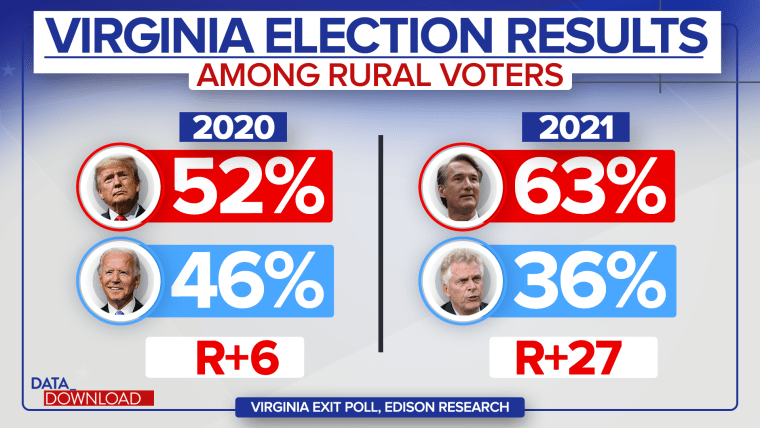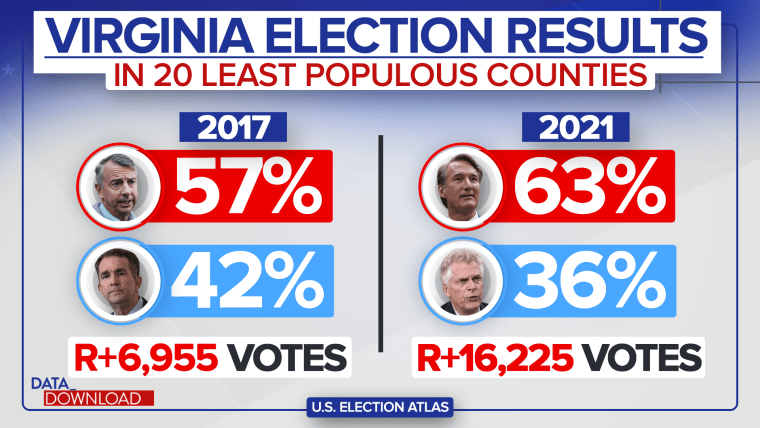WASHINGTON — Republicans had a satisfying Election Day last week, particularly in Virginia, where Glenn Youngkin captured the governor's mansion after former President Donald Trump lost the state by 10 points in 2020. There were a number of factors behind that big swing; one of the biggest was the GOP's strength in the rural parts of the state.
One question going into the election was whether rural voters, who were so crucial to Trump's coalition, would show up. Tuesday provided a resounding answer.
Republicans didn't just run up the margins in the rural parts of Virginia; they cranked up turnout, as well.

President Joe Biden lost rural Virginia by about 6 points last year. The loss wasn't a surprise; Republicans generally do better in rural communities than Democrats. But that was a close margin.
Tuesday, one year later, Democrat Terry McAuliffe lost the rural vote in Virginia by 27 points in his bid to be governor. The margin was four times larger than Biden's.
And the size of the loss has impacts elsewhere in the state. Even if Democrats rightly think of themselves as the party of urban America, margins matter. Making up a 26-point rural deficit in cities and suburbs is much harder than making up a 6-point gap.
Adding to the Democrats' problems in Virginia was just how revved up voters in rural communities were. They turned out in big numbers.

In 2020, rural voters produced 16 percent of the total ballots in Virginia. In 2021, those voters produced 19 percent of the total.
The 3-point difference might not sound like a lot, but it adds up to tens of thousands of votes. The impact of the bigger Republican rural margins grows as the rural slice of the pie gets bigger, and the slice got quite a bit bigger Tuesday.
Consider the impact in the 20 least populous communities in Virginia (that includes counties and independent cities). In 2017, Democratic Gov. Ralph Northam lost them, but not by the same margins and not with the same turnout as last week.

Four years ago, Northam won the governor's race comfortably by 9 points. Big margins in the northern part of the state were key, but even in smaller communities, he kept it relatively close.
On Tuesday, McAuliffe lost those same counties by 27 points, but because of higher turnout, his net loss in the vote was more than twice as great. Youngkin netted more than 16,000 votes out of those counties.
In fact, in those 20 counties, McAuliffe won slightly more votes than Northam did in 2017. He got 109 percent of Northam's vote total. But in the same counties, Youngkin did far better. He won 141 percent of the votes Republican Ed Gillespie won in 2017.
Those kinds of numbers were replicated across the state in the south and the west, where there are rural communities that tend to vote Republican.
None of this means that the rural surge is the sole reason for the outcome. Across the state, in fact, Youngkin seemed to do a better job of bringing out Trump voters than McAuliffe did at bringing out Biden voters. And if McAuliffe had just drawn more votes out of Northern Virginia and gotten Democratic turnout levels closer to 2020, he might have eked out a win.
But after last year, many political observers wondered about rural turnout in a post-Trump world. Would those voters come out without their man in the White House? The answer, for this year anyway, sure looks like a yes. And for Democrats, that's a problem.
It's fine being the party of urban (and much of suburban) America, but there's a difference between losing rural areas by 10 or 15 as opposed to 25 or 30 points. The latter leaves much less margin for error.
And if rural voters are charged up the way they were Tuesday, Democrats are going to need make those places at least a little more competitive.